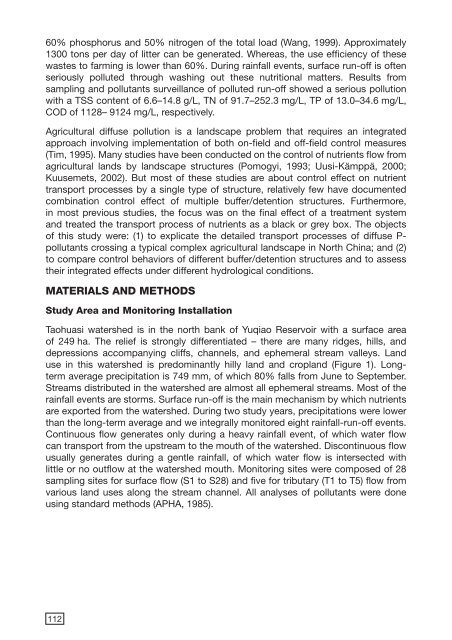Download as a PDF - CiteSeerX
Download as a PDF - CiteSeerX
Download as a PDF - CiteSeerX
You also want an ePaper? Increase the reach of your titles
YUMPU automatically turns print PDFs into web optimized ePapers that Google loves.
60% phosphorus and 50% nitrogen of the total load (Wang, 1999). Approximately<br />
1300 tons per day of litter can be generated. Where<strong>as</strong>, the use efficiency of these<br />
w<strong>as</strong>tes to farming is lower than 60%. During rainfall events, surface run-off is often<br />
seriously polluted through w<strong>as</strong>hing out these nutritional matters. Results from<br />
sampling and pollutants surveillance of polluted run-off showed a serious pollution<br />
with a TSS content of 6.6–14.8 g/L, TN of 91.7–252.3 mg/L, TP of 13.0–34.6 mg/L,<br />
COD of 1128– 9124 mg/L, respectively.<br />
Agricultural diffuse pollution is a landscape problem that requires an integrated<br />
approach involving implementation of both on-field and off-field control me<strong>as</strong>ures<br />
(Tim, 1995). Many studies have been conducted on the control of nutrients flow from<br />
agricultural lands by landscape structures (Pomogyi, 1993; Uusi-Kämppä, 2000;<br />
Kuusemets, 2002). But most of these studies are about control effect on nutrient<br />
transport processes by a single type of structure, relatively few have documented<br />
combination control effect of multiple buffer/detention structures. Furthermore,<br />
in most previous studies, the focus w<strong>as</strong> on the final effect of a treatment system<br />
and treated the transport process of nutrients <strong>as</strong> a black or grey box. The objects<br />
of this study were: (1) to explicate the detailed transport processes of diffuse P-<br />
pollutants crossing a typical complex agricultural landscape in North China; and (2)<br />
to compare control behaviors of different buffer/detention structures and to <strong>as</strong>sess<br />
their integrated effects under different hydrological conditions.<br />
MATERIALS AND METHODS<br />
Study Area and Monitoring Installation<br />
Taohu<strong>as</strong>i watershed is in the north bank of Yuqiao Reservoir with a surface area<br />
of 249 ha. The relief is strongly differentiated – there are many ridges, hills, and<br />
depressions accompanying cliffs, channels, and ephemeral stream valleys. Land<br />
use in this watershed is predominantly hilly land and cropland (Figure 1). Longterm<br />
average precipitation is 749 mm, of which 80% falls from June to September.<br />
Streams distributed in the watershed are almost all ephemeral streams. Most of the<br />
rainfall events are storms. Surface run-off is the main mechanism by which nutrients<br />
are exported from the watershed. During two study years, precipitations were lower<br />
than the long-term average and we integrally monitored eight rainfall-run-off events.<br />
Continuous flow generates only during a heavy rainfall event, of which water flow<br />
can transport from the upstream to the mouth of the watershed. Discontinuous flow<br />
usually generates during a gentle rainfall, of which water flow is intersected with<br />
little or no outflow at the watershed mouth. Monitoring sites were composed of 28<br />
sampling sites for surface flow (S1 to S28) and five for tributary (T1 to T5) flow from<br />
various land uses along the stream channel. All analyses of pollutants were done<br />
using standard methods (APHA, 1985).<br />
112

















